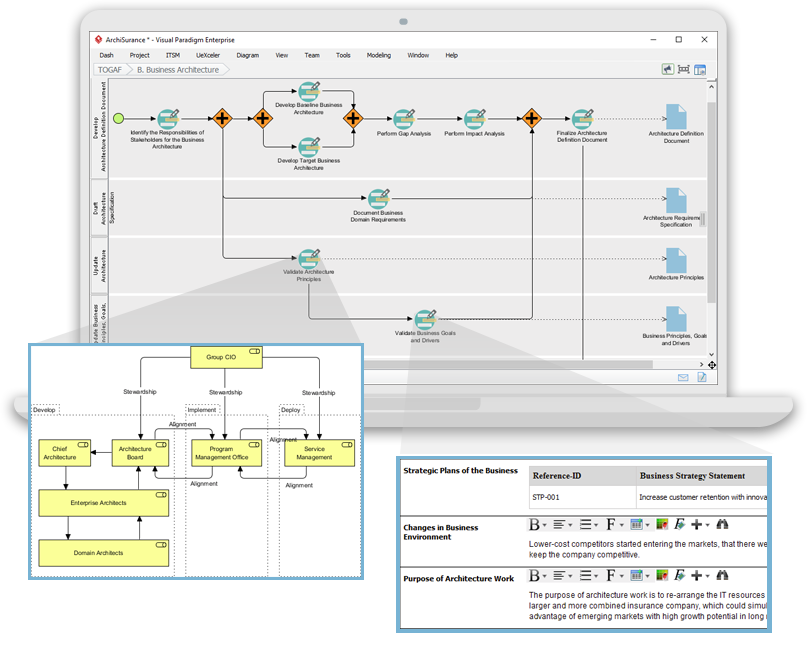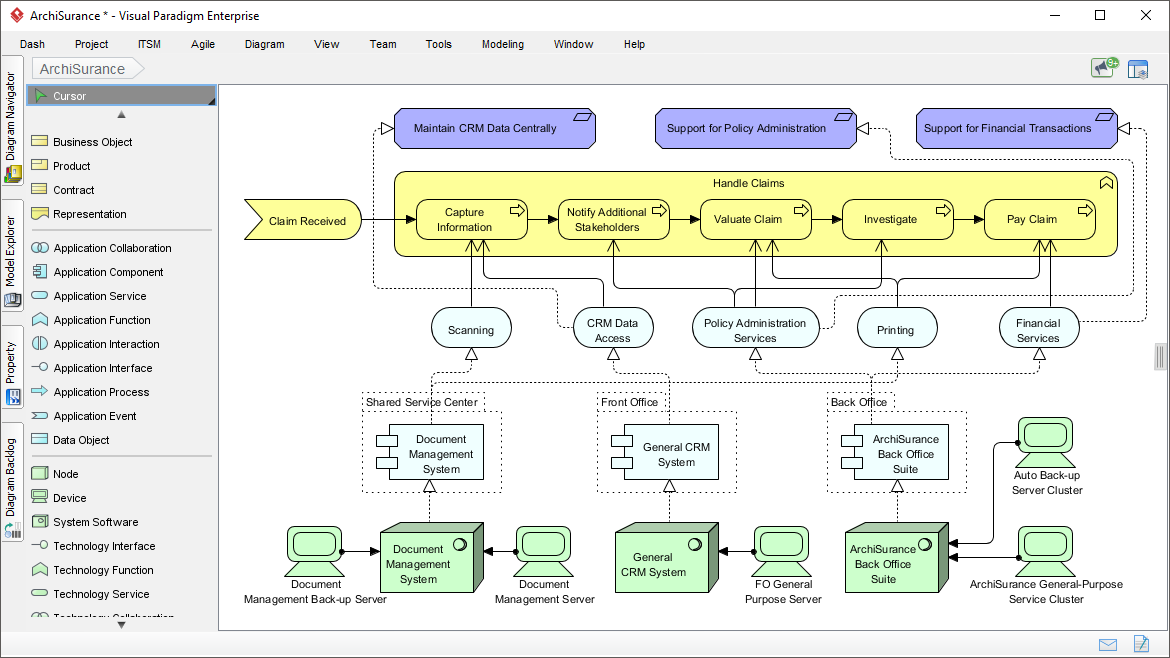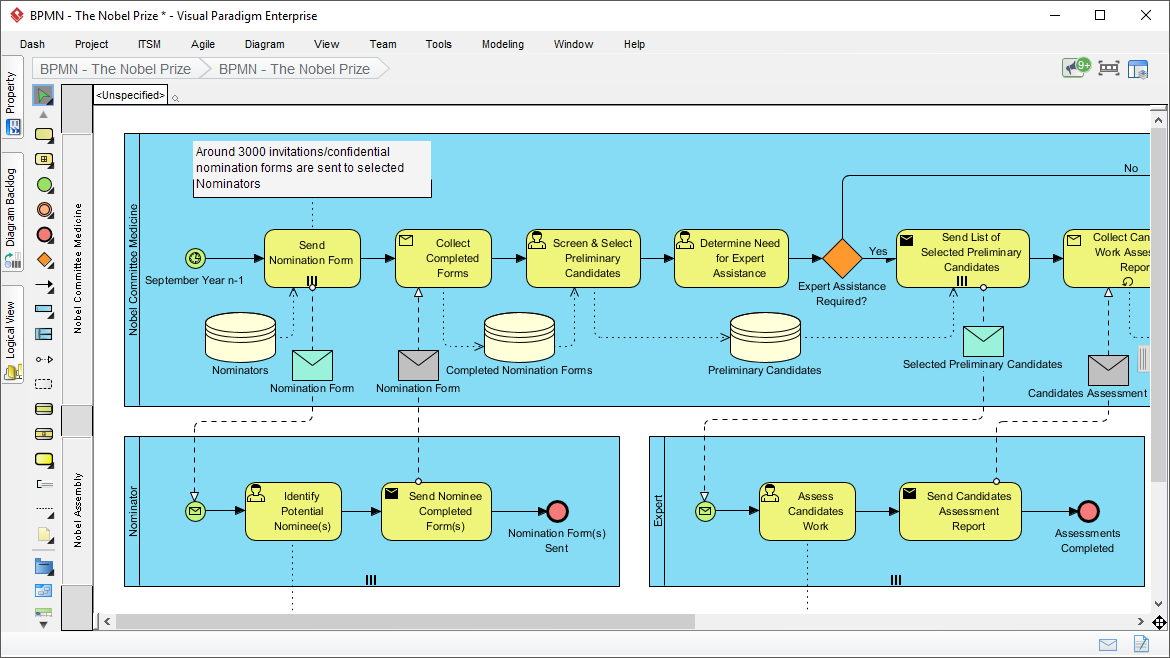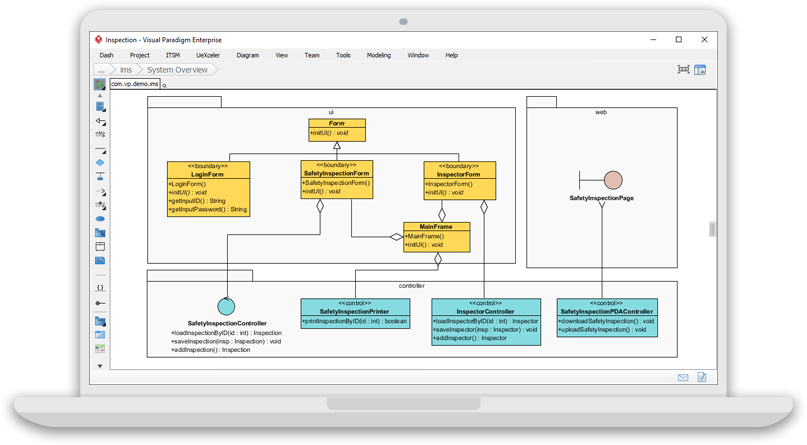Visual Paradigm stands out as the ultimate all-in-one visual modeling platform, offering unparalleled support for enterprise architecture, business process modeling, and software design. Unlike other tools that may focus on specific areas, Visual Paradigm provides a comprehensive suite of features that seamlessly integrate multiple frameworks and notations, making it a standout choice for organizations seeking a holistic approach to modeling and design.

1. TOGAF and ADM (Architecture Development Method)
Overview of TOGAF and ADM
TOGAF (The Open Group Architecture Framework) is a widely used framework for enterprise architecture. The Architecture Development Method (ADM) is the core of TOGAF, providing a step-by-step approach to developing and managing enterprise architectures.
How Visual Paradigm Excels with TOGAF and ADM
Visual Paradigm offers unmatched support for TOGAF and ADM, enabling organizations to align their business and IT strategies effectively.
Key Features:
- TOGAF ADM Process Navigator: Visual Paradigm includes a dedicated ADM process navigator that guides users through each phase of the ADM cycle, ensuring a structured and systematic approach.
- Artifact Templates: Predefined templates for TOGAF artifacts such as Architecture Vision, Business Scenarios, Stakeholder Map, and more, saving time and ensuring consistency.
- Viewpoints and Views: Supports the creation of TOGAF-compliant viewpoints and views to address stakeholder concerns, providing a comprehensive view of the architecture.
- Traceability: Ensures traceability between artifacts, phases, and requirements, maintaining coherence and alignment throughout the project.
- Repository: Centralized repository for storing and managing architecture artifacts, ensuring consistency and reusability.
- Integration with ArchiMate: Seamless integration with ArchiMate for modeling architecture components, offering a cohesive approach to enterprise architecture.
2. ArchiMate

Overview of ArchiMate
ArchiMate is a modeling language for enterprise architecture that provides a unified way to describe, analyze, and visualize architecture domains (Business, Application, and Technology).
How Visual Paradigm Excels with ArchiMate
Visual Paradigm offers robust support for ArchiMate, enabling users to create detailed and standardized enterprise architecture models.
Key Features:
- ArchiMate Modeling Tool: Full support for ArchiMate 3.1 notation, including all layers (Business, Application, Technology, Physical, Motivation, and Implementation & Migration).
- Predefined Diagrams: Templates for creating ArchiMate diagrams such as Strategy, Business Process, Application Cooperation, Infrastructure, and more, streamlining the modeling process.
- Cross-Layer Modeling: Ability to model relationships across different layers (e.g., linking business processes to applications and infrastructure), providing a holistic view of the architecture.
- Viewpoints: Supports ArchiMate viewpoints to address specific stakeholder concerns, ensuring that all perspectives are considered.
- Integration with TOGAF: Aligns ArchiMate models with TOGAF ADM phases for a cohesive enterprise architecture approach.
- Simulation: Simulate and analyze the impact of changes in the architecture, enabling proactive decision-making.
3. BPMN (Business Process Model and Notation)

Overview of BPMN
BPMN is a standardized notation for modeling business processes, enabling organizations to visualize, analyze, and improve their workflows.
How Visual Paradigm Excels with BPMN
Visual Paradigm provides a user-friendly environment for creating BPMN diagrams, ensuring clarity and consistency in process modeling.
Key Features:
- BPMN 2.0 Compliance: Full support for BPMN 2.0, including events, activities, gateways, flows, and pools/lanes, ensuring adherence to industry standards.
- Process Simulation: Simulate business processes to identify bottlenecks and optimize performance, driving continuous improvement.
- Collaboration: Collaborate with stakeholders to design and refine processes, fostering a collaborative approach to process improvement.
- Process Documentation: Generate detailed documentation for BPMN diagrams, ensuring comprehensive understanding and communication.
- Integration with UML and ArchiMate: Link business processes to other models, such as use cases or architecture components, providing a unified view of the enterprise.
- Process Analysis: Analyze process performance using metrics and KPIs, enabling data-driven decision-making.
4. UML (Unified Modeling Language)

Overview of UML
UML is a standardized modeling language used for visualizing, specifying, constructing, and documenting software systems.
How Visual Paradigm Excels with UML
Visual Paradigm is a leading UML tool, offering extensive support for all UML diagram types and advanced modeling features.
Key Features:
- UML 2.5 Compliance: Supports all 14 UML diagram types, including Use Case, Class, Sequence, Activity, State Machine, and more, ensuring comprehensive coverage.
- Code Engineering: Generate code from UML diagrams and reverse engineer code into UML models, streamlining the development process.
- Model Validation: Validate UML models to ensure consistency and correctness, reducing errors and improving quality.
- Team Collaboration: Collaborate with team members in real-time using shared projects, fostering a collaborative approach to software design.
- Integration with Other Notations: Seamlessly integrate UML with BPMN, ArchiMate, and other notations, providing a unified view of the enterprise.
- Customizable Templates: Create and reuse custom templates for UML diagrams, saving time and ensuring consistency.
- Documentation Generation: Automatically generate comprehensive documentation from UML models, ensuring thorough communication and understanding.
5. Integration and Collaboration
Visual Paradigm excels in integrating multiple frameworks and notations, enabling organizations to create a holistic view of their enterprise architecture and business processes.
Key Integration Features:
- Cross-Framework Modeling: Link TOGAF artifacts, ArchiMate models, BPMN processes, and UML diagrams to ensure alignment across all levels, providing a cohesive approach to enterprise architecture.
- Centralized Repository: Store and manage all models and artifacts in a single repository for easy access and version control, ensuring consistency and reusability.
- Team Collaboration: Collaborate with stakeholders using shared projects, comments, and task management features, fostering a collaborative approach to enterprise architecture and design.
- Reporting and Documentation: Generate consolidated reports and documentation that combine elements from TOGAF, ArchiMate, BPMN, and UML, providing a comprehensive view of the enterprise.
6. Getting Started with Visual Paradigm
Steps to Use Visual Paradigm for TOGAF, ADM, ArchiMate, BPMN, and UML:
- Install Visual Paradigm: Download and install Visual Paradigm on your system.
- Select a Framework: Choose the framework or notation you want to work with (e.g., TOGAF, ArchiMate, BPMN, or UML).
- Create a Project: Start a new project and select the appropriate template.
- Use the Process Navigator: For TOGAF, use the ADM process navigator to guide your work.
- Create Diagrams: Use the drag-and-drop interface to create diagrams and models.
- Link Artifacts: Establish relationships between artifacts across different frameworks.
- Simulate and Analyze: Use simulation tools to analyze processes and architectures.
- Generate Reports: Export diagrams, models, and documentation for stakeholders.
7. Conclusion
Visual Paradigm stands out as the ultimate all-in-one visual modeling platform, offering unparalleled support for TOGAF, ADM, ArchiMate, BPMN, and UML. Its comprehensive features, seamless integration, and user-friendly interface make it an ideal choice for enterprise architects, business analysts, and software designers. By leveraging Visual Paradigm, organizations can align their business and IT strategies, optimize processes, and deliver high-quality software solutions, setting it apart from other tools in the market.